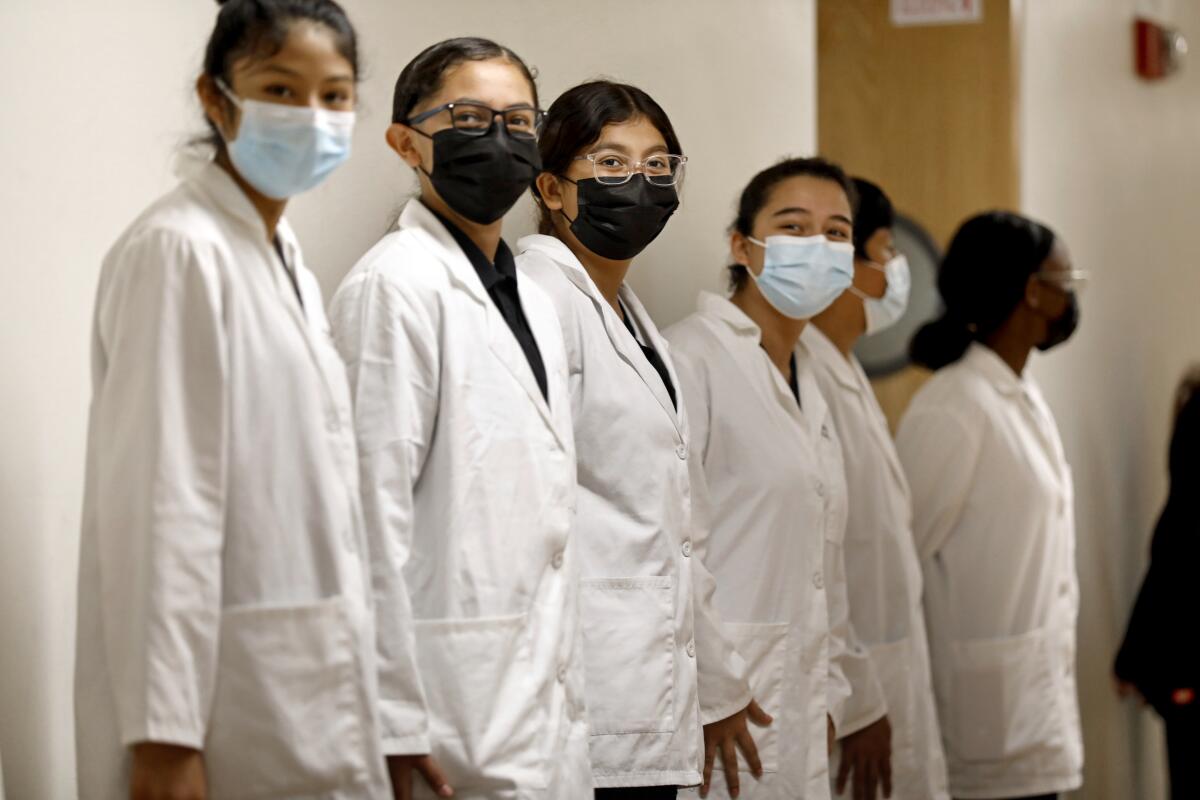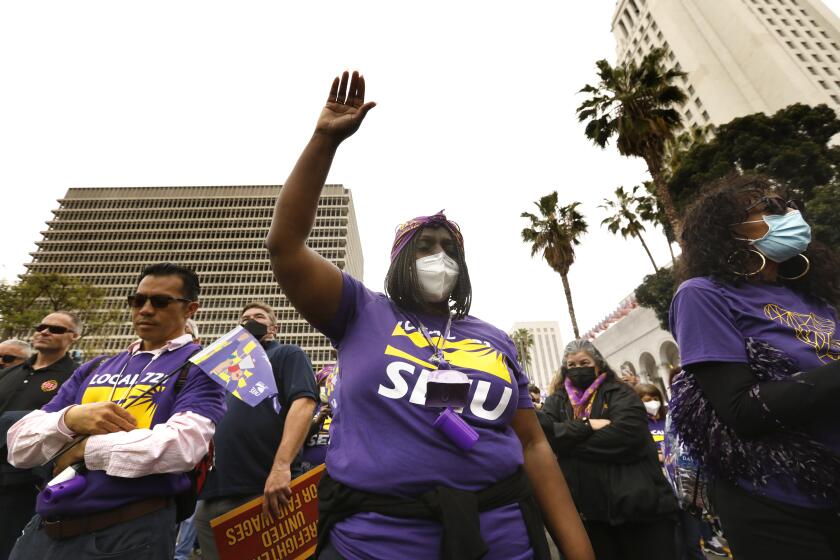California says asymptomatic people exposed to coronavirus don’t need to quarantine

- Share via
California is no longer recommending a five-day quarantine period for people who are exposed to the coronavirus but remain asymptomatic, a move that could potentially result in a relaxation of similar rules in Los Angeles County.
Doing so, officials say, would relieve the burden for employers and institutions to keep otherwise healthy people at home following exposure. The move also reflects a new pandemic reality, according to state officials — that slowly but steadily increasing vaccination rates and the availability of anti-COVID drugs are reducing the overall risk of California’s hospitals being overwhelmed in potential future surges.
The California Department of Public Health still recommends everyone who tests positive or shows COVID-19 symptoms, regardless of vaccination status, isolate and stay home for at least five days following the onset of illness or after the date of the first positive test. The state says isolation can end after the fifth day if the person has no symptoms, or the symptoms are resolving, and a rapid test result on the fifth day is negative.
Individual counties can keep rules in place that are stricter than the state’s, if local health officials believe it’s necessary. Currently, L.A. County requires those exposed to the coronavirus who are either unvaccinated or not up-to-date with their first booster shot to quarantine for at least five days following their last exposure to an infected person.
However, county Public Health Director Barbara Ferrer signaled Wednesday that discussions are underway to relax that rule locally.
“The science has changed,” Ferrer said during a discussion held by USC’s Keck School of Medicine.
For the first time in a decade, the mortality rate for Latinos in L.A. County surpasses that of white residents, starting in 2020 — with the pandemic.
Only the quarantine guideline issued by the state was relaxed. Quarantines are intended to keep people exposed to the virus at home until enough time has passed to see if they test positive or become sick. If someone under quarantine ends up testing positive or showing symptoms, they go under isolation, and the isolation guidelines remain unchanged.
Someone is considered exposed to the coronavirus if they share the same indoor airspace — like a home, clinic waiting room or airplane — with an infected person during his or her contagious period for at least 15 minutes over a 24-hour period.
An April 6 memo issued by the California Department of Public Health, however, suggests that L.A. County’s current quarantine policy has become outdated. The overwhelmingly dominant Omicron variant has a much shorter incubation than previous versions of the coronavirus that circulated throughout the state, with symptoms becoming apparent just two to three days after exposure, on average.
That incubation period is now so short that by the time a newly infected person has told their close contacts they’ve been exposed to the coronavirus, the close contacts’ incubation period is over, too, “and the most relevant time period for restricting movement by quarantine has passed,” state officials said.
Most Californians have been either vaccinated or previously infected with the coronavirus. With case rates still at relatively lower levels and anti-COVID drugs becoming more available, the risk of severe illness and death or a collapsing hospital system are dramatically reduced compared to earlier phases of the pandemic, officials said.
“Additionally, the financial, social and societal burden of having those exposed stay home is high, particularly for certain populations, including children and economically vulnerable communities,” the state Department of Public Health said.
Here’s what you need to know amid a holiday season — including Easter, Ramadan and Passover — spring break and events like Coachella and Stagecoach.
California’s latest quarantine recommendations are more relaxed than those issued by the U.S. Centers for Disease Control and Prevention. The CDC still recommends that those exposed to the coronavirus, and not up-to-date on COVID-19 vaccinations, stay home and quarantine for at least five days to see if they develop signs of illness.
The state’s memo emphasized this guidance could be changed if a more virulent variant emerges, or there are future surges of a new variant. California has also retained stricter quarantine guidelines for people in certain high-risk settings, such as nursing home residents who are not up to date on their vaccines. They are still advised to quarantine for at least five days.
The state also says that K-12 schools may allow asymptomatic exposed students, regardless of vaccination status, to stay in school unless they develop symptoms of illness or test positive. But state officials strongly recommend those students wear a well-fitting mask indoors around other people for at least 10 days following the date of their last exposure.
Data show that for the seven-day period that ended Monday, an average of 960 new cases were reported daily countywide, which pencils out to 67 cases a week for every 100,000 residents. That’s up 23% from the previous week.
California’s quarantine guidelines are just the latest pandemic-era measure to be substantially relaxed in recent months, as the state emerged from one of the worst COVID-19 waves yet.
COVID-19 hospitalizations have plunged, from an Omicron peak of just above 15,400 in mid-January to 1,040 as of Tuesday.
New infections have also nosedived. During the height of Omicron, the state was reporting more than 120,000 additional coronavirus cases a day, on average. As of last week, the daily average is in the neighborhood of 2,800, according to state data compiled by The Times.
But as of late, cases have started to creep back up — a modest reversal some health officials say can be attributed both to the widespread relaxation of indoor mask and vaccine-verification mandates as well as the waning of vaccine-induced and natural immunity.
Given this time of year is marked not just by major holidays but spring break travel and recreation, officials say it remains vital for residents to take steps to protect themselves from infection.
According to the most recent data from the California Department of Public Health, unvaccinated Californians were almost four times more likely to get COVID-19, seven times more likely to require hospitalization and 14 times more likely to die from the disease than their vaccinated-and-boosted counterparts.
“While COVID-19 hospitalization rates are near an all-time low, we are seeing an increase in COVID-19 transmission in some parts of the state,” said Dr. Tomás Aragón, the state’s director of public health and health officer. “This underscores the need for Californians to remain vigilant and protect themselves and their communities by getting vaccinated and boosted. Vaccines continue to offer strong protection against COVID-19.”
More to Read
Sign up for Essential California
The most important California stories and recommendations in your inbox every morning.
You may occasionally receive promotional content from the Los Angeles Times.















